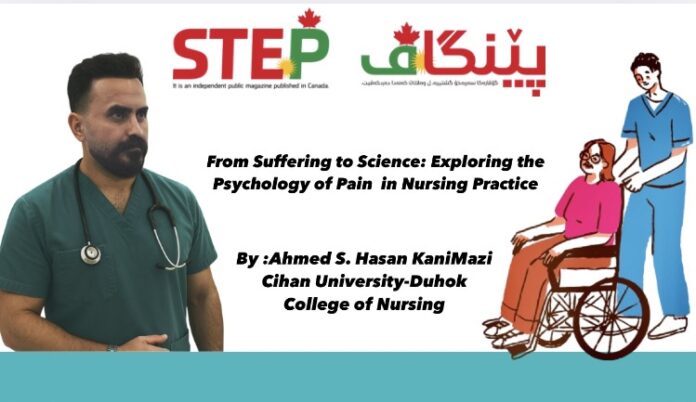By :Ahmed S. Hasan KaniMazi
Cihan University-Duhok
College of Nursing
During one clinical rotation in the High Dependency Unit (HDU), I witnessed a scene that left an indelible mark on my understanding of human suffering. An elderly man, fragile and weathered by time, lay in bed crying inconsolably—his cries echoing not just physical pain, but a deeper emotional torment. It was a rare and profoundly human moment. Despite all the medical interventions surrounding him, his pain was unrelenting, and for a moment, he seemed like a child—defenseless and exposed. That powerful encounter became the inspiration behind my inquiry into the psychology of pain—a field that bridges neuroscience, emotional health, and clinical care.
Pain is often misconstrued as a purely physical phenomenon—a symptom to be alleviated or suppressed. However, modern science and clinical psychology reveal that pain is a complex and multidimensional experience, shaped by physiological processes, emotional states, cognitive perceptions, and sociocultural contexts. This integrative perspective is captured in the biopsychosocial model of pain (Engel, 1977), which posits that pain arises from an intricate interplay between biological mechanisms (e.g., nociceptive pathways), psychological factors (e.g., mood, beliefs, and attention), and social influences (e.g., cultural norms, family dynamics, and support systems).
At the core of pain perception lies nociception, the neural process by which harmful stimuli are detected and transmitted to the central nervous system. But nociception alone does not define pain. Research in neuroscience has demonstrated that pain is interpreted and modulated in the brain by regions such as the somatosensory cortex, which identifies location and intensity, and the amygdala and anterior cingulate cortex, which influence the emotional and motivational responses to pain. This explains why two individuals experiencing the same injury may report vastly different pain levels—because pain is not merely what the body feels, but what the mind perceives.
One of the most influential theories in pain science, the Gate Control Theory (Melzack & Wall, 1965), underscores the role of psychological processes in modulating pain. According to this theory, pain signals must pass through “gates” in the spinal cord that can be opened or closed depending on various factors, including emotional state, cognitive focus, and past experiences. Anxiety, for instance, can intensify pain perception, while distraction or positive expectation can significantly reduce it—a concept well demonstrated by placebo analgesia, where belief in treatment alone can trigger the brain’s natural release of endorphins.
In clinical nursing, these insights translate into practice through comprehensive pain assessments and holistic pain management strategies. Nurses must not only ask about pain intensity using tools such as the Numeric Rating Scale (NRS) or Visual Analog Scale (VAS) but also explore psychological and social dimensions through open-ended, empathetic communication. Understanding the patient’s emotional landscape—whether marked by fear, isolation, depression, or trauma—is critical for tailoring effective interventions.
Moreover, culture profoundly influences how individuals perceive, express, and cope with pain. For example, patients from collectivist cultures may underreport pain to avoid burdening others, while others may openly verbalize their distress. These cultural nuances demand that nurses practice cultural competence—the ability to recognize and respect diverse health beliefs and behaviors—in order to deliver individualized and compassionate care.
Importantly, psychological interventions such as Cognitive Behavioral Therapy (CBT), relaxation techniques, guided imagery, and mindfulness-based stress reduction have emerged as evidence-based modalities to address the emotional component of pain. These approaches work by altering maladaptive thought patterns, promoting emotional regulation, and activating neural circuits that enhance resilience and pain tolerance.
The implications of this holistic understanding are especially critical in the era of the opioid crisis, where the overreliance on pharmacological pain relief has led to widespread issues of addiction and tolerance. Non-pharmacological methods, when integrated thoughtfully alongside pharmacologic treatments, offer a safer, more sustainable pathway to pain relief. Nurses, as frontline caregivers, play a pivotal role in advocating for these balanced approaches, educating patients, and ensuring adherence to evidence-based pain management plans.
Reflecting on the incident in the HDU, I now recognize that what I witnessed was not just a man in physical pain—it was a person suffering on multiple levels, each layer demanding recognition and response. That experience transformed my perspective as a nursing student. It taught me that pain is not a singular symptom to treat but a narrative to be understood. It taught me that every expression of pain is a call for connection—an appeal to be seen, heard, and helped.
As we advance in nursing education and clinical practice, embracing the psychology of pain is not merely an academic endeavor—it is a moral and professional responsibility. By doing so, we affirm our commitment to holistic, human-centered care—where science meets empathy, and where the cry of a suffering patient becomes the beginning of healing, not just in the body, but in the mind and soul as well.





